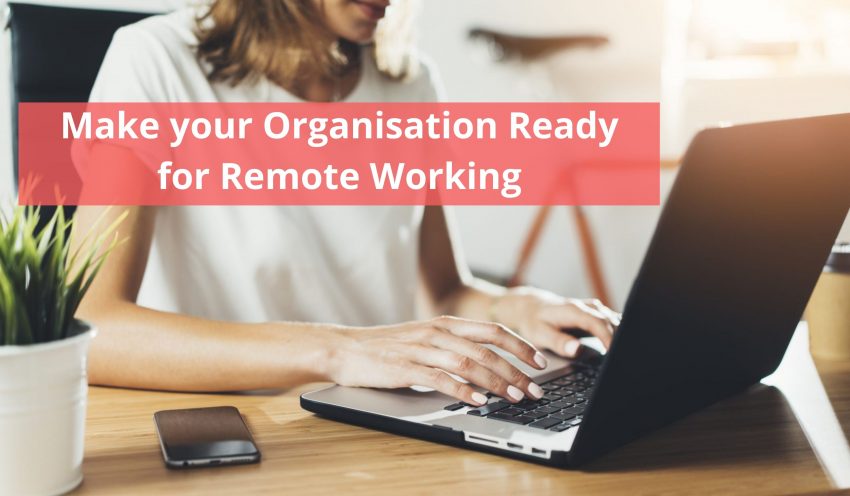The main objective of the governments throughout the world right now is to flatten the life-threatening curve and slow the spread of the COVID-19 pandemic. The companies globally have to adapt to a new working strategy to sustain this unprecedented situation. For many organizations, remote working was not part of the policy, but they are making swift and thoughtful changes to enable their workforce to thrive in a remote working environment.
Here are a few steps you can consider to ensure your organisation is ready for working with remote teams:
Enabling Effective Communication:
Communication plays an effective role in ensuring your workforce can collaborate flawlessly with one another and even deliver effective results to clients/customers.
Identifying the right technology for the right form of communication is key to achieving productivity, and avoiding interruption in workflow. Here’s how the different channels can be leveraged for enabling communication and effective collaboration:
- Video Conferencing:
Video conferencing is not a new word for most of the companies but right now it has been a boon for almost every industry. This is one of the great collaboration channels to utilize during this crisis. Tools like Zoom, Hangouts, Webex, Microsoft teams, etc which make virtual working as easy and seamless as it can get
- Document Sharing & Collaborative Content Creation
Sharing files and documents through emails has always been a part of our job but now it has become more essential for effective collaboration more than ever. Virtual working requires help in joint documentation, live co-editing, etc and can be done without the use of sophisticated tools
These tools can be used for creating a structured repository of information, version control management, and for sharing files across the organization. Some software that can come handy are Google Drive, Dropbox, etc.
- Social Conferencing& Project management
As if lockdown wasn’t bogging enough, one-sided communication can be quite boring during these times. So involving the teams into activities such as social team-talk, seeking guidance and collaboration, encouraging teams to have peer to peer recognition can serve as a good way to engage and motivate the workforce.
Keeping track of tasks, performance management, product status checks, and backlog prioritisation can be done through effective task management tools like Jira, Good Day etc.
- Engagement initiatives:
To make it more the work more engaging during work from home, interactive learning sessions, Q&A sessions, and polls are another great way of building relationships with your teams and workforce on the large. Some great tools to achieve this are Zaggle Propel, an employee reward, recognition and engagement platform that has features like social timeline, badges, polls & surveys and also an option to redeem points that are awarded to employees
- Maintaining Continuity with Technology and Infrastructure:
COVID-19 has proven that the companies that are able to harness the power of technology and are able to fast track their digital transformations will be the most beneficial in these uncertain times. Some requirements that organisations should be aware of:
- Enabling Infrastructure:
A stable internet connection, technological equipment for smooth workflow such as computers/laptops, microphones, etc should be provided or compensated for. Working from remote areas will be a difficult task for the workforce who are accustomed to the office environment. Enabling the proper infrastructure can eliminate that feeling to a certain extent.
- HR Technology:
Talent leaders have to make courageous decisions every day but now they are pushed to live by a new set of rules to ensure employee safety and protecting business continuity.
HRMS platforms which are playing a crucial role in the current scenario. These automated platforms help to carry out activities such as tracking attendance, broadcasting information, driving performance, maintaining contact information, expediting query resolution, and all other HR-related tasks and activities.
- Client Communication Channels:
For client-facing employees, the infrastructure and technology support have to be continuously enabled to communicate, interact, and engage with external customers and clients to ensure contact and proper conversion.
- Security Protocols
Data protection is the most important subject that has to be taken care of. Although we ensure that employees protect the data there are some third-party tools that may cause internal cookies to capture and save our data.
Enforcing the strict security policy through-out the organisation for anti-malware, firewalls, etc. for employees using their personal devices as well as organization-managed devices becomes paramount from the perspective of data security. Enabling multi-factor authentication to ensure that access, whether to cloud-based services or full network access, is given to authorized users only.
These are just guidelines that may help ease out some of the challenges that most organizations across the globe are facing today. Hopefully, we all come out being the better versions of ourselves but till then #StayHomeStaySafe

 Login/Sign Up
Login/Sign Up
 Redeem Zaggle Propel Card
Redeem Zaggle Propel Card
 Manage Zaggle Cards
Manage Zaggle Cards

Great info. Lucky me I ran across your blog by accident.
I have book-marked it for later!